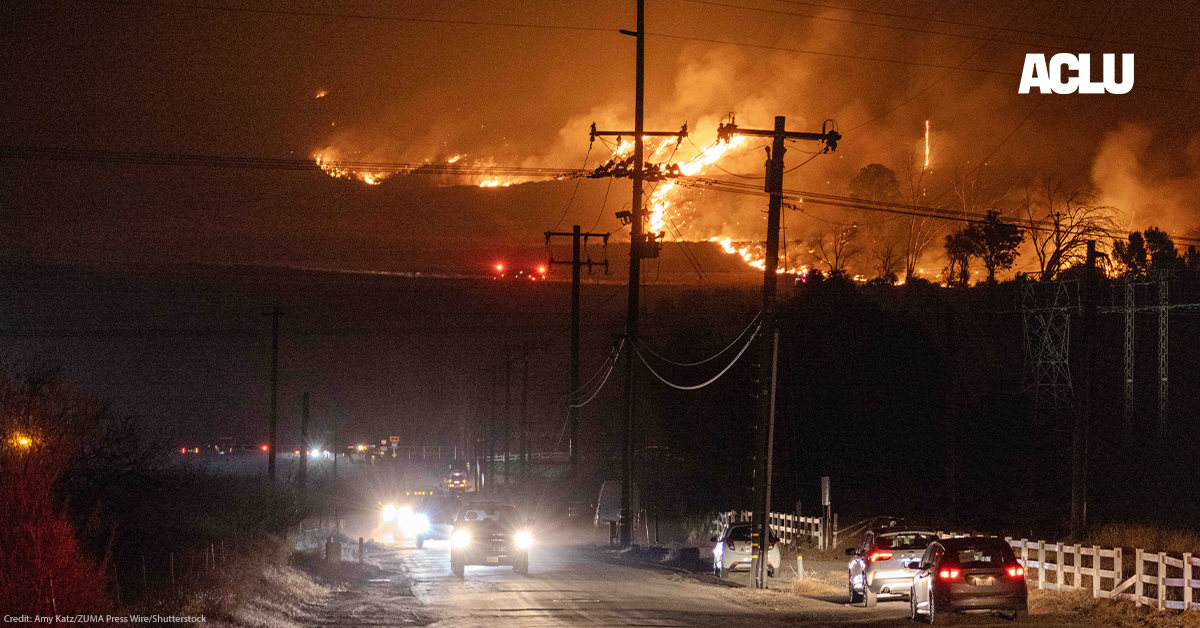
At least 29 people perished in the Palisades and Eaton fires. Tens of thousands have lost their homes or been displaced, and millions more have felt the trauma and disruption of these events. Still, mandatory evacuation orders saved countless lives.
But approximately 13,000 people incarcerated across L.A. County jails and juvenile halls experience these catastrophes without any ability to protect themselves. As fires engulfed the Pacific Palisades and Altadena, the Hurst Fire burned less than a mile away from the Barry J. Nidorf Juvenile Hall, where 96 youth were incarcerated in an evacuation warning zone. Teenagers at the facility reported that they could see the mountains burning nearby. Nearby residents were evacuated and the courthouse adjacent to the juvenile hall was closed, but the youth and staff at Nidorf were never relocated to safety.
On January 23, a brushfire broke out in the Angeles National Forest in the northern part of L.A. County. In fewer than seven hours, the Hughes Fire exploded to close to 10,000 acres, and 31,000 people in the inhabited areas nearby were under mandatory evacuation orders from Sheriff Robert Luna.
But there was one conspicuous exception to Sheriff Luna’s evacuation order – the 4,700 people incarcerated in four L.A. jail facilities in Castaic and hundreds of staff working there. Not only were the jails firmly in a mandatory evacuation zone, but they also stood directly in the path of the fire’s growing southern edge.
Advocates and concerned constituents, including people whose loved ones were trapped in the jails, called on county leaders and the sheriff to evacuate immediately. However, not a single incarcerated person was evacuated from the mandatory evacuation zone. While approximately 470 incarcerated people were moved from one jail to another in the same complex, over 5,000 people sheltered in place while the fire raged overnight.
Reports indicate that the thousands locked in the Castaic jail complex were not given updates as the fire progressed. One can only imagine the fear endured by those in the jails and their loved ones, all anxiously waiting for the morning. , whose son was trapped in the jails, told us she was “absolutely terrified.” “You’re powerless,” she added, “absolutely powerless.” And worries remain. The s in Altadena survived the Eaton fire but closed for several days due to smoke damage and air quality. The public has not heard any reports about the air or water quality at the Castaic jail complex in the days after the fire.
Thanks to heroic efforts by state and local responders – including incarcerated firefighters being paid less than $20 a day – and the sheer luck of favorable wind speed and direction, firefighters stopped the Hughes Fire just half a mile from the jail complex. If the Hughes Fire had erupted just a few weeks ago, at the same time and with the same high winds as the Palisades and Eaton fires, we likely would have borne witness to the largest carceral disaster in U.S. history.
L.A. County escaped disaster by a half a mile. Our brush with catastrophe must spur local and state leaders to action. County leaders must demand effective evacuation plans for people in custody and the working deputies, directed and approved by fire officials well in advance of a disaster. State and county leaders across the country must take stock of jails and prisons at risk for fires, floods, earthquakes, and other natural disasters. The task is immense because the United States has the highest incarceration rate of any country in the world, and L.A. County’s jail system is the largest in the world. It doesn’t have to be this way.
County leaders have committed to a “Care First, Jails Last” approach to public health and safety. The best path out of harm’s way remains a deep investment in alternatives to incarceration. Programs like the Office of Diversion and Reentry have successfully diverted thousands of people out of jail. In L.A. County and around the country, alternatives to incarceration can shrink our grossly outsized carceral footprint, making it much easier for us to protect our communities from coming disasters.
The fires remind us that climate change is here. We must move quickly to protect incarcerated people who cannot save themselves in an emergency. Next time, we may not be so lucky.
Melissa Camacho is senior staff attorney in the Criminal Justice Project at the ACLU of Southern California and Mari Dominguez-Ruiz is staff attorney with the ACLU National Prison Project.
This post was originally published on this site be sure to check out more of their content.









